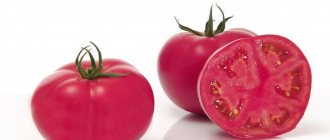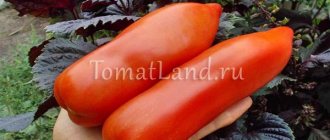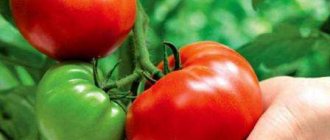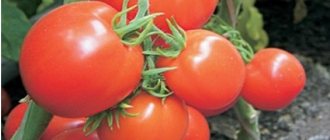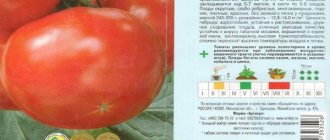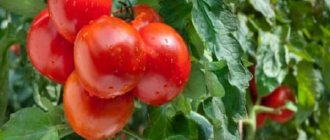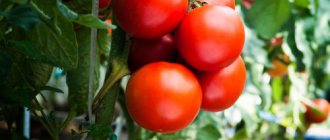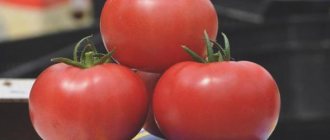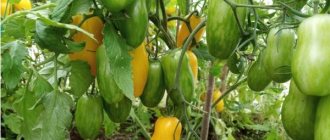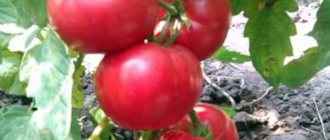Tomato Shalun is an excellent productive variety of cherry tomatoes that look like large red berries. They have an excellent taste and aroma, and the bush is resistant to disease and looks beautiful in the garden.
| Height | Landing location | Ripening time | Fruit color | Fruit size | Origin | Fruit shape |
| Tall | Greenhouse | Early ripening | Reds | Small | Variety | Round |
A harvest guest from Siberia - Tomato Buyan: a complete description of the variety and features of its cultivation
The Buyan group is famous for its unpretentious plants with red and yellow fruits. The variety is adapted to the harsh summer seasons of Siberia. Ease of cultivation, large yields, and uniform tomatoes have made Buyan a favorite in many areas.
| Height | Landing location | Ripening time | Fruit color | Fruit size | Origin | Fruit shape |
| short | Greenhouse, Open ground | Early ripening | Reds | Average | Variety | Plum-shaped or oval |
Description and characteristics of the variety
Buyan is a determinate, low-growing variety with shoots up to 50-60 cm long. What is convenient in work, tomatoes do without gartering and pinching.
Tomato Buyan from Siberian Garden is an early ripening variety with fruit ripening time of 90-100 days after germination. The bushes are low, but strong and powerful.
Tomato Fighter or Buyan are synonyms of the same variety. Designed for areas with risky farming. The fruits are red and plum-shaped. The pulp is juicy with 4-5 seed chambers. The taste is slightly sweet with moderate tomato sourness.
Origin of the variety and region of growth
The variety was born thanks to Siberian breeders. In 2012, it was included in the register as a variety recommended for open and closed areas. First of all, it was intended for cultivation in Siberia and cold latitudes. Perfectly adapted to fruiting in temperate and southern regions.
Advantages and disadvantages
Pros:
- productivity;
- amicable maturation;
- early ripeness;
- universal application;
- ease of cultivation;
- resistance to tobacco mosaic.
Minuses:
Productivity
From 1 m2 they harvest 25 kg, from 1 plant the yield is 4-5 kg. The fruits have an average weight of 90-150 g. Tomatoes are used for fresh cuts and salads, rolled whole in jars, and homemade preparations: pastes, juice, ketchups.
Features of cultivation and storage
Buyan is planted through seedlings. Bushes that have reached 50-55 days from germination are transplanted into beds. The soil is fed in advance with organic matter and mineral fertilizers. Caring for a tomato is simple, its main points:
- Watering is infrequent - 2 times a week at the root with warm water. 1 bush needs 3 liters;
- loosening and removing weeds;
- mulching with sawdust, leaf litter, straw.
Plants are fed at the flowering stage, ovary formation and when pouring tomatoes.
Due to their short stature, you don’t have to tie the tomatoes to a trellis, pin them, or shape them.
The shelf life of the fruit is 1-1.5 weeks in cool, dark rooms.
Planting and care
Seeds are sown 50 days before transplanting to the beds. Pre-soak in saline solution, then in potassium permanganate. The soil mixture is prepared from:
- leaf turf;
- compost;
- peat;
- sand;
- ash.
To disinfect, treat with 1% potassium permanganate, pour boiling water over it or bake in the oven for 20 minutes.
Plant the seeds to a depth of 1.5-2 cm, leaving a distance of 2 cm between the grooves.
Before germination, the boxes are covered with film and put in a warm place. Further care of seedlings includes a number of activities.
- Hardening at 15 °C for a week.
- Then a temperature regime of 22-24 °C is recommended.
- Irrigation through a spray bottle.
- Diving in the presence of 3 true leaves.
- Feeding with mineral solution 10 days after diving.
Seedlings are ready for planting in beds when they have 7-10 leaves.
Diseases and pests
Among all tomato varieties, it is one of the most resistant to pathogens. You should be wary of the following diseases:
- Late blight. It manifests itself as browning of leaves and fruits followed by falling off. Occurs during periods of rain and excessive humidity. For prevention, spray with Bordeaux mixture and copper sulfate. “Fitosporin”, “Fundazol”, “Ordan” are effective for the fight.
- Gray and apical rot. Dark spots appear on the fruits. To cope with the disease, saltpeter irrigation and proper watering are used.
- Cracking of fruits. The reason is excessive watering and fertilizing, and lack of sunlight.
Of the pests, attention is paid to aphids, whiteflies, mole crickets, and tomato cutworms. Effective drugs against insects:
- "Karate";
- "Pro";
- "Aktofit".
Early maturing / Low-growing User rating: 4/5 Early maturing / Low-growing User rating: 5/5 Early maturing / Low-growing User rating: 5/5
Diseases and pests
Tomatoes require protection from major viral and fungal diseases. The top layer of soil must be renewed annually; for prevention, the soil is generously spilled with an aqueous solution of potassium permanganate or copper sulfate. This procedure will help destroy pathogens of fungal diseases.
To prevent late blight, it is recommended to spray the bushes with copper-containing preparations. Damaged leaves or fruits are immediately torn off and burned. There are varieties of tomatoes that are not susceptible to this disease. The greenhouse must be ventilated frequently to prevent the air from becoming too humid. Land turnover will help prevent viral diseases. Tomatoes cannot be planted in beds that were previously occupied by nightshades: other varieties of tomatoes, eggplants, peppers, potatoes.
Ideal predecessors for tomatoes are a variety of legumes, cabbage, carrots or herbs.
In open ground, plants are often attacked by pests. To prevent their occurrence, the soil should be mulched with peat, straw or humus. Any weeds that appear must be removed. Plantings must be inspected frequently, looking under the leaves. Having discovered pest larvae, they are collected by hand or washed off with warm water and laundry soap.
An aqueous solution of ammonia, which is periodically sprayed on the plantings, will help get rid of slugs. Spicy herbs planted along the ridges can repel flying insects: parsley, mint, celery.
In case of severe pest damage, tomatoes can be treated with insecticides. Spraying is carried out 2-3 times with an interval of several days. Treatment can be carried out before the formation of ovaries; during the fruiting period, toxic drugs are excluded.
Greenhouse conditions
In the Urals, the Yenisei hybrid is recommended to be grown under cover. The tomato is much more productive and larger than its counterparts in the garden. Plants are tied up immediately after planting, and subsequently they are pinched. The growing system is similar to that described for the vegetable garden, taking into account the following circumstances:
- For better pollination, plants are periodically shaken or a brush is used.
- The temperature of tomatoes varies between 20 – 30 °C.
- To prevent fungal diseases caused by high humidity, the greenhouse is regularly ventilated.
- Fertilize the soil weekly.
With this care, the first vegetables can be enjoyed in July.
Characteristics and description of the tomato variety Zhigalo, its yield
Zhigalo tomatoes are an original variety that amazed everyone with its unusual oblong shape and taste. This is a high-yielding variety that can be eaten raw, as well as salted and pickled. Fruits are always expected at the end of summer if seedlings are planted in May. This plant is a standard one; the bush never grows more than 50 centimeters, which makes it easier to care for. The variety is not a hybrid, so it is quite possible to germinate its seeds for seedlings.
More about tomato
The description and characteristics of tomatoes can help you study the rules for caring for them.
This variety was developed by breeders. The bush is small, it does not require tying or pinching. The foliage is moderate, the inflorescences are simple. Fruit ripening usually occurs three months after germination.
There are a lot of fruits on the bush, they hang like a toy on a Christmas tree, 6-7 pieces hang on the brush. The shape of these fruits is very unusual. Elongated, rectangular with a rounding at the base. Similar to pepper. Color ranges from orange to red. Length up to 12 centimeters, weight up to 150 grams. The pulp is dense, the taste is sweet, but acid is also present.
This tomato is good for preparing salads, as well as various preparations for the winter: pasta, adjika, pickling, salting. It will be delicious to make dried or sun-dried tomatoes from them. They look very nice in jars. They can be collected unripe and stored until they turn red. But, ripening on the branch, the taste will seem brighter.
During ripening, simultaneous harvesting occurs. This variety is good for sale and is normal for transportation, since their skin is dense and thick. Doesn't crack.
This variety of tomatoes can be grown by anyone, even a novice gardener.
It is important to know the features and requirements for growing them.
Features of cultivation
These tomatoes are grown in seedlings from germinated seeds. They begin to be planted in March. After sowing, you need to cover with film and monitor the temperature, it should not be lower than 18 degrees. Before planting, you can soak the seeds in a special solution, which will protect future plantings from diseases and help them germinate faster.
It is important to provide sufficient light to the shoots. After several leaves appear on them, they can be seated apart from each other
Plant only mature seedlings that have a dense core and are hardened to plant in the garden. This is usually done in May. The soil for plants is prepared in autumn and spring. It should be soft, light, rich in fertilizers
For these tomatoes, it is important that there be fertilizing in the form of potassium, magnesium, phosphorus, copper, manure, chicken droppings, and humus. All this allows you to grow juicy, healthy fruits.
Typically, three months pass from sowing the seeds to the start of fruiting. In this regard, the variety can be considered mid-season
All this time, attention from gardeners and quality care are important for tomatoes.
Care and concern
A feature of these tomatoes is the low size of the bushes. Therefore, caring for them will be much easier: you don’t need to tie them up, cut off excess shoots or foliage. Stepping should be carried out only in cases where there are too many extra shoots.
During the growth of these crops, it is necessary to provide them with high-quality, abundant watering.
It is important to do this only with warm, settled water from a barrel. Water at the root, not on the foliage
The foliage can be sprayed a little on a hot day.
The earth is loosened, hilled, removing weeds. Weeds take away nutrients from vegetable crops. Preventative measures are being taken to combat harmful insects. To do this, spray the bushes with special solutions purchased in the store.
There should always be enough light
It is also important to monitor the level of humidity and acidity. They should not exceed the norm
This tomato variety loves good fertile soil, so it is important not to forget to feed them. No need for pinching
They rarely get sick. You can sometimes spray foliage and tomatoes with remedies for certain diseases, soak seeds against fungus
No need for pinching. They rarely get sick. You can sometimes spray foliage and tomatoes with remedies for certain diseases, or soak seeds against fungus.
Those who have ever planted Zhigalo tomatoes have been satisfied with them. The tomato has positive ratings and recommendations for growing.
Lydia: I planted this variety twice. I really like them, they are convenient to cut into salads and stuff. Adjika from them is not watery, thick. The bushes were not sick. The yield is plentiful. Unusual shape. Even children like it. I recommend this variety to those who have small greenhouses.
Zhigalo is a tomato chosen by lovers of unusual varieties.
In order for there to be more harvest, it is necessary to constantly pay attention to the crop and follow all the rules of care. Then tomatoes will delight you with delicious juicy fruits
Happy landing!
Golden fingers
The bushes of this variety are low, weakly leafy. They produce yellow-orange cylindrical fruits. They ripen almost simultaneously and do not fall off for a long time. Their pulp and skin are quite dense, which allows them to be stored and canned without losing their shape or cracking. The variety is resistant to many diseases: tobacco mosaic virus, bacteriosis, late blight, fusarium, etc.
| Purpose | Growing | Ripening time (days) | Fruit weight (g) | Number of fruits per hand | |
| 80-100 | 15-30 | 18-20 | |||
Tomato "Roma" VF: description
| External form | Slightly elongated, ovoid, often with a well-defined nose. |
| Color | Red with green stripes that disappear as they ripen. |
| Average weight | 60-90 grams. |
| Application | Universal. |
| Productivity per square meter | 13-15 kilograms per square meter. |
| Marketable condition | Good presentation, excellent preservation during long-term storage of fresh tomatoes. |
The “Roma” VF tomato bush is of determinate type, reaching a height of 55-60 centimeters. The average ripening time, from planting seeds to receiving the first ripened tomatoes, takes 118-123 days. The leaves are medium sized and green. When growing, it is recommended to tie the stems to a vertical support to prevent the bush from lodging under the weight of the formed fruits. Resistant to fusarium and verticillium, but very easily infected with late blight.
The fruit weight of the variety can be compared with other tomatoes in the table below:
| Variety name | Fruit weight |
| Roma | 60-90 grams |
| Ballerina | 60-100 grams |
| f1 favorite | 115-140 grams |
| Tsar Peter | 130 grams |
| Peter the First | 30-250 grams |
| Black Moor | 50 grams |
| Apples in the snow | 50-70 grams |
| Samara | 85-100 grams |
| Sensei | 400 grams |
| Cranberries in sugar | 15 grams |
| Raspberry Viscount | 400-450 grams |
| The Tsar Bell | up to 800 grams |
The plant does not tolerate increased humidity and temperature changes. Under unfavorable conditions, bushes become stretched in height and plant yields sharply decrease. The best yield is when the bush is formed with two stems. Constant regular removal of stepchildren is required.
h2>Advantages and disadvantages
The advantages include:
- disease resistance;
- good yield;
- high level of preservation of fresh fruits.
Disadvantage: It easily suffers from late blight.
Procurement of seeds
Seeds can be purchased in specialized places or prepared independently. Seed collection follows the standard scheme:
- Ripe tomatoes of the correct shape are selected from the most productive bushes.
- Selected vegetables are placed in a warm place until fully ripe (the tomatoes should become soft).
- The seeds are removed from the ripened fruits and washed under running water. The seeds should be well separated from each other.
- The washed seed material is laid out on an absorbent dry cloth so that they do not touch and dried for two days.
- Dried seeds should be placed in paper bags and stored in a dry, warm place until spring sowing.
Characteristics and description of the Alsou tomato variety, its yield
Already from the middle of winter, gardeners and gardeners begin to actively prepare for the spring season and, first of all, buy seeds for seedlings. The Alsou tomato will be a good choice for those who want to grow a rich harvest in the fall.
Description of the tomato variety Alsou
It was bred relatively recently, in the early 2000s, by Siberian breeders. The Alsou variety is a determinant variety (distinguished by low-growing bushes). The bushes grow to a certain height, usually from 65 to 85 cm. There is no need to pinch the top to stop growth. In greenhouse conditions, the Alsou tomato grows from 1 to 1.5 meters.
Reviews from those gardeners who grew the variety on their plots indicate that the plant’s trunk is very weak and needs to be tied up. Stepping is also necessary. Tomato productivity is high, especially if you create ideal growing conditions for the plant; it is important to apply mineral and organic fertilizers during the season
Characteristics of the Alsou tomato
Before planting Alsou tomatoes on your garden plot, you need to study the characteristics and description of the variety. What are the features of this variety?
Description and characteristics of tomato:
- High yield;
- It is resistant to various diseases;
- A mid-early variety, it takes about 90-120 days from the appearance of the first shoots to harvest;
- From one bush you can collect up to 9 kg of ripe fruits;
- The trunk of the plant is weak, not branched, and has a small amount of tops;
- Garter required;
- The main characteristic that distinguishes the variety from all others is the simple inflorescences and joints on the legs;
- Unripe fruits are light green in color;
- Ripe tomatoes are pink, there may be a green spot near the stalk;
- The skin is dense, smooth, not ribbed;
- The pulp is juicy, tender, like most rose varieties, quite sweet;
- The average weight of a tomato is about 600, maximum weight is 1.5 kg;
- A small number of seeds in the fruits;
- Suitable for cultivation in both the southern and northern regions of Russia;
- Due to the large size of the fruits, the variety is not suitable for preservation in its entirety;
- They tolerate long-term transportation well and have good commercial qualities.
Advantages and disadvantages
If everything is clear with the description of Alsou tomatoes, then it is also important to study all the advantages and disadvantages of this variety of nightshade crop. Advantages:
Advantages:
- Gives a rich harvest;
- From one bush you can collect up to 9 kg of fruit;
- Resistant to diseases;
- Good taste;
- Tolerates both drought and cool weather well;
- Ripe tomatoes do not crack;
- The fruits are large in size.
Flaws:
- “Alsu” tomatoes have a weak trunk; it needs to be tied up so that it does not break under the weight of the fruit;
- Stepping is necessary;
- Due to the fact that tomato fruits are very large, they are not suitable for canning in their entirety.
Despite the shortcomings, reviews from those who planted the Alsou tomato are mostly positive.
Features of growing in open ground
To get a good harvest in the fall, you need to grow seedlings correctly. Planting material is planted in the soil at the end of March - beginning of April or 55-60 days before planting seedlings in open ground. After two or three leaves appear on the seedlings, it needs to be pruned. To make the seeds germinate faster, you can germinate them in advance.
How to germinate seeds correctly:
- Planting material must be soaked in water until it swells;
- Dry slightly and place moistened natural fabric between layers;
- The container with the cloth should be placed in a warm place for 2-3 days until the first shoots appear;
- After the sprouts have appeared, the seeds need to be dried a little until they flow and planted in the soil.
It is recommended to harden off the seedlings several weeks before planting in the soil. Containers with bushes should be taken out into fresh air for 2-3 hours, constantly increasing the time.
To prevent the bushes from interfering with each other, I will plant the seedlings at a distance of 40 cm.
Growing Tips:
- It is advisable to plant seedlings in places where zucchini, cucumbers, parsley, dill or eggplants previously grew;
- Before planting seeds in open ground, they must be soaked in a weak solution of potassium permanganate for one hour, and then washed in clean warm water;
- Due to the fact that the Alsou tomato variety has very weak trunks, they must be tied to trellises.
Reliable hero of Chelyabinsk selection
The mid-season, super-large-fruited tomato Yenisei F1 corresponds to this definition. The weight of a bright, smooth tomato with pulp that melts in your mouth reaches 500 g or more. This “heavyweight” is served fresh, in a salad, and it’s nice to drink a glass of juice. It is not suitable for canning whole fruits due to its large size. The main advantage of the hybrid is the abundant harvest of products.
Basic indicators:
- Average height is up to 1.5 m.
- Attractive bush habit.
- The period from germination to ripe tomatoes lasts 110 - 120 days.
- Correct fruit shape, fine grain, excellent balanced taste.
- Easy adaptation to changing environmental conditions, resistance to late blight.
Every summer resident dreams of a combination of such qualities - the characteristics are impressive, they inspire respect and admiration. High productivity is not hindered by poor lighting and cool summers.
Description of the Alsou tomato variety, its characteristics and yield
It’s rare that a summer resident regrets choosing the Alsou tomato for planting. An early harvest of large, sweet tomatoes is always welcome. Alsou is just such a variety: it ripens early, has a good taste, and is not picky about care.
Description
The Alsou tomato variety can be considered new, but proven; it was included in the State Register in 2007. An important point is that Alsou tomatoes are successfully grown in all regions of the Russian Federation. Excellent results are obtained when growing tomatoes in greenhouses and open ground. The tomatoes are early in terms of ripening.
Description of all the important characteristics of a tomato bush:
- determinant type;
- height in open ground 80 cm;
- height in the greenhouse from 100 to 130 cm;
- the number of leaves is average;
- the leaf size is medium, the color is light green;
- The trunk is fragile and requires tying to a support.
Fruit
This variety is usually selected after reading a description of the main characteristics of the fruit. Lovers of fleshy, large tomatoes cannot deny themselves the pleasure of growing specimens weighing up to 700 g. The fruits with 6 nests have a flat-round shape with mild ribbing.
The pulp is juicy, medium density, sweet. The fruits at technical ripeness are green with a pronounced dark green spot in the area of the stalk. When biological maturity is reached, the stain disappears, the skin and pulp turn red.
The fruits are recommended to be used for the prevention of diseases; the pulp contains antioxidants and is characterized by a high content of lycopene. The productivity of the Alsou tomato deserves attention - 7 kg/m². Not every variety can produce such a number of fruits. Those who planted Alsou note a weak dependence of yield on weather conditions.
The purpose of the fruit is salad. They are unsuitable for whole-fruit canning due to the large size of the tomatoes. They are usually used for preparing light, summer salads, snacks, juice, sauces and borscht dressing.
Features of cultivation
Tomatoes of the Alsou variety are early, so there is no need to rush into sowing seeds for seedlings if there is no spring greenhouse. If available, its seeds can be sown in early March. The age of seedlings ready for transplantation should be 55–60 days. It is bad for growing to have overgrown seedlings (over 60 days old), but too young seedlings also have their disadvantages:
- bears fruit later;
- gets sick more often;
- Pollinated worse.
What to consider when sowing seedlings?
Experienced gardeners believe that growing seedlings in purchased soil should be preferred to growing them in soil taken from your own garden.
Reviews contain information that this variety adapts more easily to open ground conditions if the seedlings grew in garden soil.
It is difficult to highlight any specific features for caring for seedlings. All maintenance work is standard:
- watering at least once a week, if there is a high content of peat or coconut fiber in the soil, up to 3 times a week, before watering you should feel the soil with your finger, water if the top layer has already dried out;
- fertilizing is needed, it is convenient to use Zdraven complex fertilizer for seedlings, it is produced in liquid form, which is very convenient when preparing a working solution, it comes with a measuring cap, with which it is easy to maintain the required dosage;
- in the phase of 2 true leaves, the seedlings are dived, it is preferable to dive into separate containers with a volume of 0.5 liters; by the time of transplantation into a greenhouse or open ground, a well-developed root system is formed in the plants, planting is painless, the plants adapt to the new place within a few days .
Transfer
It is not difficult to transplant healthy seedlings. The day before, you need to water it well, then it’s easier to get it out of the cups. I need to prepare the ridge at least a week before planting. Apply fertilizers (urea, superphosphate, potassium sulfate) under digging or directly into the holes.
The holes can be placed according to a 40x50 cm pattern. For the Alsou tomato, dense planting of 5 bushes per square meter is acceptable. m. This is possible because the plant is of a determinate type with compact bushes that need to be formed into 2-3 stems. Drive stakes for gartering bushes into the center of the hole. Plants can be tied to a support immediately or a few days after transplanting into the ground (greenhouse).
Maintenance measures are standard: watering, loosening the soil so that a crust does not form, removing weeds, removing stepchildren, tying up shoots, fertilizing. Watering in the greenhouse is carried out 2-3 times a week, in open ground depending on the weather, but at least once every 7 days.
At least three feedings:
- the first - 10 days after transplantation with an infusion of grass, mullein or chicken droppings;
- the second - before flowering, use any complex fertilizer for tomatoes;
- the third - during the formation of fruits, also with complex fertilizer with a predominance of phosphorus and potassium.
Soil preparation
Experienced gardeners recommend preparing the soil in the fall. To prepare the soil mixture, mix garden or forest soil, rotted humus and sand in equal quantities. Preparatory procedures take place in several stages.
- The soil mixture is sifted through a sieve with a cell diameter of no more than 8 mm.
- Add sifted ash (200 grams) and crushed eggshells (100 grams) to the soil (1 bucket), which can be replaced with chalk.
The finished soil mixture is steamed to destroy fungal spores and weed seeds. To do this, place a colander or a tin can with holes in the bottom of a metal container and pour in a little water. The container is filled with soil mixture, covered with a lid and left on medium heat for an hour and a half. After time has passed, the soil should be poured into a wider container and left until it cools completely.
The cooled soil should be packaged in large plastic bags, securely closed and stored. It is important to add ash in the fall so that it has time to neutralize before spring. Active ash can burn the roots of seedlings.
If the soil is prepared immediately before sowing seeds, then ash should not be added.
And when the seedlings sprout, water them twice with ash extract. To prepare the extract, you need to pour ten liters of water into a glass of ash and leave for 24 hours. Before watering, the solution must be filtered.
Seed preparation begins at the end of winter:
- sort and sort the seed material, selecting large specimens of the correct shape
- selected seeds are placed in a gauze or fabric bag and kept in a strong manganese solution for about 30 minutes
- disinfected seeds are washed under running water for 20 minutes without removing them from the bag
- washed seeds are placed on a wet cloth fertilized with microfertilizers for home flowers and a growth stimulator
- The seed material is covered with polyethylene on top, preventing it from coming into contact with the seeds, and placed in a warm place
- after a day, the seeds are placed in the lower compartment of the refrigerator for 3-4 hours, and then again in a warm place for a day. The alternation is repeated three times and left warm for germination.
The roots should appear in three to five days, after which you can start sowing. The time for sowing tomatoes differs in different climatic zones. Planting is carried out when the threat of spring frosts has passed. If conditions are favorable, the seedlings will be ready for transplanting into the ground in two months. If you plan to grow tomatoes in a greenhouse, then sow the seeds for seedlings three weeks earlier.
Seedling containers are filled with prepared soil and sown tomato seeds are sown into it, deepening it to 5 cm.
The crops are watered, covered with polyethylene and placed in a warm place. Within a week, the seeds will sprout. With the emergence of seedlings, the polyethylene is removed, the soil is moistened and the seedlings are placed in a well-lit place.
If the seedlings are grown in a common box, then when two pairs of leaves appear, they need to be planted in separate containers. This is done so that the seedlings do not stretch out and their root system becomes stronger. After picking, the seedlings need to be regularly watered and fed with complex mineral fertilizers.
Until recently, gardeners had no problems choosing a tomato variety, because they had to be content with the availability of available seed. Twenty years ago the range of tomatoes was small.
Now so many varietal and hybrid varieties of this crop have been bred that it is difficult to choose the right ones from such a variety. The seed packages depict luxurious bushes with bunches of beautiful tomatoes. The description promises a rich harvest and excellent taste.
However, the qualities of certain tomato varieties declared by seed producers do not always correspond to reality. This is explained by the incorrectness of their choice for a given region with certain climatic conditions, the method of cultivation (greenhouse or open ground), and the applied agrotechnical conditions for growing tomatoes.
Before choosing seeds of suitable varieties, you need to decide on several factors:
- Local climate. The reason that good high-yielding varieties bear little fruit may be their inadequacy for a given region. Thus, Siberian types of tomatoes, which are distinguished by their tolerance to unfavorable temperature conditions, diseases, and pests, can produce full harvests in any climatic conditions. But southern varieties will bear little fruit in cold areas, even in greenhouses; some will not grow at all. The high yield indicators declared by sellers correspond to reality only in those regions where plants have a long growing season, when several harvests can be harvested from one bush.
- Where will the tomatoes grow - in a greenhouse or open ground. This question is very important. There are few universal varieties of tomatoes that can bear fruit equally well in stationary greenhouses and in the fresh air. Most species of these plants are adapted only to certain conditions. Therefore, you need to be especially careful when choosing seeds based on these indicators.
- The purpose of cultivation is for salads, canning or for sale. If you prefer to provide your diet with fresh tomatoes during the season, which are distinguished by their excellent taste and nutrient content, choose salad varieties. But such tomatoes are not stored for a long time and are not suitable for preservation. For preparations for the winter, it is better to choose special ones, which are medium and small in size, denser pulp, and strong peel. The taste and percentage of nutrients are noticeably lower than that of salad vegetables. There are even fewer of them in varieties for commercial cultivation - they are characterized by a long shelf life, high yield, in which their properties are reduced due to the number of fruits.
- Bush shape - low-growing (determinant) or tall (indeterminate) varieties. Tomatoes whose bush height is 50-70 cm are considered determinant. They are also found lower. Their cultivation is suitable for “lazy” and novice gardeners. Because such plants do not require much hassle with pruning and tying, some of them do not need to be tied at all. Indeterminate varieties are convenient to grow in small areas, but they require careful care for the formation of bushes, regular correct pinching, and for them you need to create special supports for garter. They grow up to 1.5 m or more.
- When is the harvest planned? To provide your summer diet with fresh tomatoes, choose early salad varieties. For harvesting, medium and late varieties are planted. In total, experienced gardeners grow several types of tomatoes on their plots, so as not only to receive fresh vegetables for the table all season, but also to insure themselves if any of them turns out to be low-yielding.
READ MORE: Apricot Russian variety description, fruiting characteristics and care
Having a good greenhouse at your disposal, you can get fresh tomatoes to your table all year round.
To do this, several varieties are planted with different ripening periods.
Salad varieties
The real battles unfolded during voting for the most productive varieties of tomatoes that our readers grew in their beds. They were evaluated according to various criteria - from frost resistance and keeping quality, to taste and pickling qualities.
Seed companies have developed a large number and variety of hybrid tomatoes. It is not easy to choose the most productive among them. The tomato harvest largely depends on agricultural technology and proper care. In this article we will talk about the differences between high-yielding tomatoes and some popular hybrids. These varieties will not disappoint you with their returns and will delight you with many advantages.
Tomatoes are one of the most popular vegetable crops; we plant them for vitamins for the summer table and tasty preparations. And if the area of the greenhouse or garden bed is limited, high-yielding varieties are needed to produce more useful fruits. Modern tomato hybrids must provide the following qualities:
- precocity;
- high yield;
- resistance to major tomato diseases;
- commercial properties of fruits: uniformity in size and shape, attractive color, absence of cracking, keeping quality and transportability;
- good taste of fruits;
- short internodes of shoots, compact arrangement of inflorescences;
- strong, short inflorescences bearing 5-7 fruits;
- the ability to continuously form fruit clusters – a generative type of development (for greenhouse indeterminate bushes).
Read about the most productive variety of cucumbers in this material.
What tomatoes can be called high-yielding? In quantitative terms, these are varieties and hybrids, from one bush of which we can get 10 or more kilograms of fruit. In greenhouses, when grown year-round, they yield up to 40-50 kg per sq.m.
Read about the Zozulya cucumber variety here.
Tomato varieties according to growth are conventionally divided into tall, medium-sized and low-growing:
- tall - reach a height of 2 m or more;
- medium-sized - have a height of about 1 - 1.5 m;
- low-growing - usually do not exceed a height of 0.8 - 0.9 m.
However, classification according to the type of branching of the bush is more common. On the packets of seeds we see the following characteristics: “determinant”, “indeterminate”, “semi-determinate”. What do these words mean in practice?
- The indeterminate type is a tomato bush that grows strongly upward. The stem grows continuously throughout the season; lateral branches, in turn, produce stepchildren of the second to fourth orders. The first fruit cluster is tied after 10–14 leaves, the subsequent ones alternate every 3–4 leaves. The indeterminate type of growth is most often characteristic of late-ripening and mid-ripening tomatoes.
- Determinate tomatoes are varieties with reduced shoot formation and the ability to self-regulate growth (such as Novichok). Stepchildren in such varieties are formed in the lower third of the stem. After the formation of 4-6 fruit clusters, the main stem stops growing and branching, the growth of the tips of the lateral shoots also stops after the formation of 2-4 inflorescences, such as Klusha
- Tomatoes of the semi-determinate type of branching occupy a middle position between these groups. Inflorescences in semi-determinate varieties are usually formed through 2 internodes. This type includes many medium-sized, less often tall, hybrids and varieties.
More about the variety
This variety is resistant to changes in weather conditions. It is easy to care for and resistant to many diseases. A description of the variety will help you figure out how to grow it and how to take care so that the harvest is abundant. And it will be big, since this type of tomato is one of the high-yielding tomato varieties.
The bush is very tall, more than two meters
Its growth is unlimited, so it is always important to ensure that it is tied up with ropes and cut off unnecessary shoots. The foliage does not grow very densely
The fruits hang in clusters on these tomatoes.
The fruits are small and weigh a little, but there are always a lot of them on one cluster. Ripening occurs approximately three months after seed germination. They can be pink or red. The taste is sweet and sour. The subtle aroma of the fruit attracts everyone. There are usually few seeds, the skin is dense. Not prone to cracking. They can be transported over distances and also grown for sale.
Reviews of tomatoes are always positive. This variety is good for salads, slices, and is also ideal for canning. If you are interested in this type of tomato, you need to carefully study how to grow and care for it.
Geranium Kiss
Geranium Kiss tomatoes were bred by an American farmer from Oregon in 2008. The variety is determinant, so the plant does not require pinching. As a result of selection, a short, compact bush with dense and dense leaves was obtained. The fruits it bears are also quite original - the size of a walnut and a small “spout” at the end. There are very few seeds in tomatoes, but their taste is original and memorable, rather like fruit.
| Purpose | Growing | Ripening time (days) | Fruit weight (g) | Number of fruits per hand | |
| 100-110 | 20-40 | 80-100 | |||
general description
The Golden Bullet tomato is a variety of yellow-fruited tomatoes. Its seeds have been sold on Russian markets since 2000. The variety is included in the state register. The originator is Russian breeder Yuri Pachev.
Distinctive features of the variety
The main characteristic feature of the variety is its bright yellow, almost orange color. The shape of the berries is elongated, like cream. This variety is distinguished by a rich, sweet and tomato sour taste of the fruit. Yellow tomatoes have a pronounced aroma. The flesh is firm but tender.
The popularity of yellow-fruited tomatoes is explained by the usefulness of such berries. They contain lycopene, which helps normalize metabolic processes, cleanses the body of waste, toxins, free radicals and bad cholesterol, fights pathogenic microflora in the intestines and has a positive effect on the condition of the heart muscle.
Beta-carotene sharpens vision, strengthens the immune system and has a positive effect on the condition of the skin. Myocin strengthens the elements of the circulatory system.
Yellow tomatoes have a reduced content of acids and allergens. Such tomatoes are suitable for feeding children and people with high acidity of gastric juice.
Golden Bullet is immune to major tomato diseases. It is unpretentious in care and requires minimal labor from the gardener.
Main characteristics
The characteristics of the Golden Bullet will not impress all gardeners. They will appeal to beginners, but will disappoint farmers who grow tomatoes for sale.
Characteristics and description of the variety:
| Parameter | Indicators |
| Bush type | Determinant. In open ground it reaches a height of 60 cm. In a greenhouse it grows up to 1 m. The stems are strong and erect. The bushes are covered with an average amount of foliage. The leaves are large, rich green, rough, dense. The inflorescences are simple. The first is formed in the axil of 6 leaves, the next ones every 1-2 leaves. Fruits are formed on clusters, 5-7 pieces on each. |
| Growing method | The variety is resistant to temperature changes. Mainly grown in open ground. Cultivation in a greenhouse is possible. |
| Productivity | Not tall. From 1 sq. On average, only 4 kg of high-quality, beautiful fruits are collected. |
| Fruit | Medium size. Typically, one berry weighs 50-60 g. Record specimens weigh 100 g. The color of the shiny skin varies from dark yellow to orange. The tomatoes are yellow inside. The shape is elongated, without ribbing at the base. There are berries with a pointed tip. The pulp is dense, but tender and juicy. The taste is rich, sweet with a characteristic tomato sourness. Inside there are 2-3 chambers with seeds. |
| Transportability | High. Tomatoes have a durable skin that protects them from damage during transportation and allows them to be stored for 3 weeks. |
| Ripening time | Mid-season. The first harvest is harvested 100-110 days after sowing the seeds. |
| Disease resistance | Has high immunity to major tomato diseases. |
Reviews, who planted
Akulina tomatoes quickly became leaders in sales, thanks to their ease of cultivation and excellent taste. You can learn more about them by reading the gardeners' assessments below.
- I found the characteristics and description of the Akulina tomato variety on one well-known website for gardeners. The information interested me, and I planted 6 bushes in the greenhouse. The opinion about the tomato was positive. He is unpretentious and non-capricious. Caring for him is a real pleasure. As for the harvest, my 6 bushes produced 30 kg of large, ripe, juicy tomatoes that taste great. I definitely recommend this variety to all summer residents. (Vladimir Alexandrovich, Nizhny Novgorod region, Tonashevo village)
- I can only leave positive reviews about this tomato. It is not at all difficult to grow, and the yield is very pleasing. The tomatoes are healthy, bright red, slightly ribbed. They turned out to be simply ideal for fresh salads. Also perfect for homemade preparations. Next year I will plant again and more. I also recommended it to all my friends. (Alevtina Vasilievna, Samara)
- We met Akulina only this year and are very happy about it. We have probably never had such juicy and meaty tomatoes. Both whole fruits and slices are suitable for rolling into jars. We also made tomato sauce and lecho. It turned out very tasty. In addition, they are bright and beautiful to look at and have become an excellent decoration for our greenhouse. (Alexandra Fedorovna, Vologda region, Cherepovets)
Marisha, St. Petersburg
Veronica, Moscow
Nadine, Volgograd
